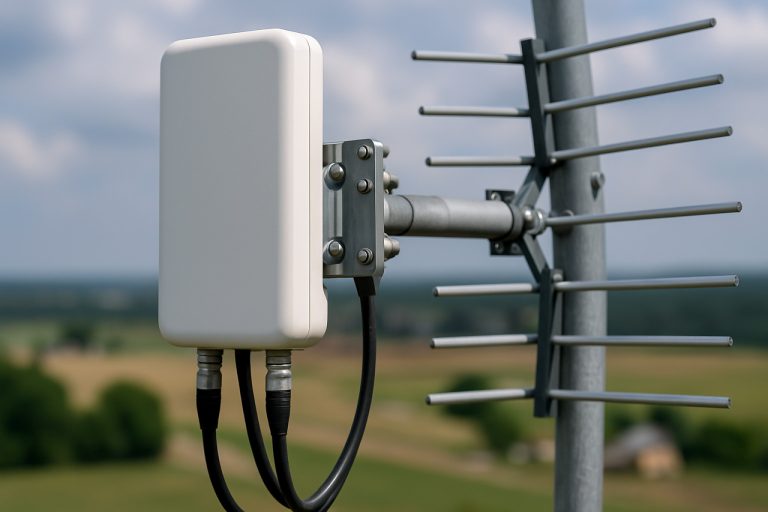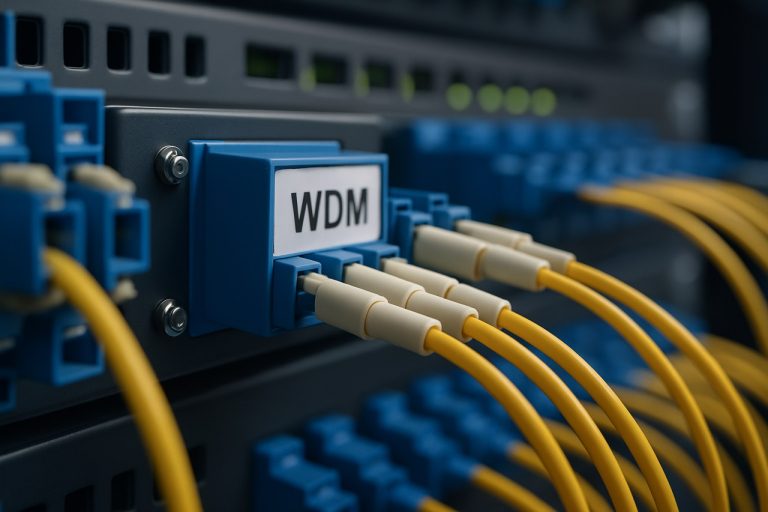
Unlocking the Power of Wavelength Division Multiplexing (WDM): How This Technology is Supercharging Data Transmission and Shaping the Future of High-Speed Communications
- Introduction to Wavelength Division Multiplexing (WDM)
- How WDM Works: Principles and Technology
- Types of WDM: CWDM vs. DWDM
- Key Benefits and Advantages of WDM
- Challenges and Limitations in WDM Implementation
- WDM in Modern Optical Networks: Use Cases and Applications
- Recent Innovations and Future Trends in WDM
- Conclusion: The Impact of WDM on Global Connectivity
- Sources & References
Introduction to Wavelength Division Multiplexing (WDM)
Wavelength Division Multiplexing (WDM) is a pivotal technology in modern optical communications, enabling the simultaneous transmission of multiple data streams over a single optical fiber by utilizing different wavelengths (or colors) of laser light. This approach dramatically increases the capacity of fiber-optic networks without requiring additional physical infrastructure, making it a cornerstone of high-speed, high-capacity data transmission systems. WDM systems are broadly categorized into two types: Coarse Wavelength Division Multiplexing (CWDM) and Dense Wavelength Division Multiplexing (DWDM), each optimized for different channel spacing and application scenarios.
The adoption of WDM has revolutionized telecommunications and data center connectivity by allowing network operators to scale bandwidth efficiently and cost-effectively. By assigning unique wavelengths to individual data channels, WDM minimizes interference and crosstalk, ensuring reliable and high-quality signal transmission over long distances. This technology supports the ever-growing demand for internet bandwidth, cloud services, and real-time data applications.
WDM’s flexibility also facilitates network upgrades and reconfigurations, as new channels can be added or removed with minimal disruption. Its compatibility with existing fiber infrastructure further enhances its appeal, allowing for seamless integration into legacy networks. As global data traffic continues to surge, WDM remains a critical enabler of scalable, future-proof optical networks, underpinning advancements in 5G, IoT, and next-generation broadband services. For more detailed information, refer to resources from the International Telecommunication Union and the Institute of Electrical and Electronics Engineers.
How WDM Works: Principles and Technology
Wavelength Division Multiplexing (WDM) operates by transmitting multiple optical carrier signals simultaneously over a single optical fiber, with each signal assigned a unique wavelength (or color) of light. The core principle relies on the fact that light of different wavelengths can coexist in the same fiber without interfering, provided that the wavelengths are sufficiently separated. At the transmitter end, multiple data streams are modulated onto lasers, each emitting at a distinct wavelength. These optical signals are then combined using a multiplexer, which merges them into a single composite signal for transmission through the fiber.
At the receiving end, a demultiplexer separates the composite signal back into its constituent wavelengths, directing each to a corresponding photodetector for data recovery. The precision of this process depends on the quality of the optical components, such as filters and multiplexers, which must maintain strict wavelength selectivity to prevent crosstalk and signal degradation. WDM systems are typically categorized as either Coarse WDM (CWDM), which uses wider channel spacing and supports fewer channels, or Dense WDM (DWDM), which employs narrow channel spacing to accommodate dozens or even hundreds of channels on a single fiber, dramatically increasing capacity.
Modern WDM technology leverages advanced components like arrayed waveguide gratings (AWGs), tunable lasers, and erbium-doped fiber amplifiers (EDFAs) to enable long-distance, high-capacity transmission with minimal signal loss. These innovations have made WDM the backbone of contemporary optical networks, supporting the exponential growth in data traffic across global communication infrastructures (International Telecommunication Union).
Types of WDM: CWDM vs. DWDM
Wavelength Division Multiplexing (WDM) encompasses two primary variants: Coarse Wavelength Division Multiplexing (CWDM) and Dense Wavelength Division Multiplexing (DWDM). Both technologies enable the transmission of multiple optical signals over a single fiber by assigning each signal a unique wavelength, but they differ significantly in channel spacing, capacity, and application scenarios.
CWDM typically uses wider channel spacing—20 nm apart—allowing up to 18 channels within the 1270 nm to 1610 nm wavelength range. This broad spacing reduces the complexity and cost of optical components, making CWDM a cost-effective solution for metropolitan area networks (MANs) and short to medium-haul applications where high capacity is not the primary requirement. CWDM systems are also less sensitive to temperature fluctuations, further reducing operational costs and complexity International Telecommunication Union (ITU).
In contrast, DWDM employs much narrower channel spacing, typically 0.8 nm (100 GHz) or even 0.4 nm (50 GHz), supporting up to 80 or more channels within the C-band (1530–1565 nm) and L-band (1565–1625 nm). This dense packing enables DWDM systems to achieve much higher aggregate bandwidth, making them ideal for long-haul and ultra-high-capacity backbone networks. DWDM also supports advanced features such as optical amplification and reconfigurable optical add-drop multiplexers (ROADMs), which are essential for dynamic, large-scale networks Cisco Systems.
In summary, CWDM offers simplicity and cost savings for moderate-capacity, shorter-distance links, while DWDM delivers the scalability and performance required for high-capacity, long-distance optical transport.
Key Benefits and Advantages of WDM
Wavelength Division Multiplexing (WDM) offers a range of significant benefits that have made it a cornerstone technology in modern optical communication networks. One of the primary advantages is its ability to dramatically increase the capacity of existing fiber infrastructure. By allowing multiple data channels, each at a different wavelength, to be transmitted simultaneously over a single optical fiber, WDM enables network operators to scale bandwidth without the need for additional fiber deployment, resulting in substantial cost savings and efficient use of resources (Cisco Systems).
Another key benefit is the flexibility and scalability WDM provides. Networks can be easily upgraded by adding new wavelengths to meet growing data demands, supporting both current and future requirements without major infrastructure changes. This modular approach is particularly valuable for service providers seeking to offer differentiated services or to adapt quickly to market changes (Nokia).
WDM also enhances network reliability and resilience. With the ability to route different wavelengths independently, operators can implement robust protection and restoration schemes, minimizing service disruptions in the event of fiber cuts or equipment failures. Furthermore, WDM supports transparent transmission of various data formats and protocols, making it highly compatible with diverse network architectures and technologies (ADVA Optical Networking).
In summary, WDM’s key advantages—capacity expansion, scalability, cost efficiency, flexibility, and enhanced reliability—make it an essential technology for meeting the ever-increasing demands of global data traffic.
Challenges and Limitations in WDM Implementation
While Wavelength Division Multiplexing (WDM) has revolutionized optical communication by dramatically increasing bandwidth, its implementation presents several technical and operational challenges. One of the primary issues is wavelength stability. Lasers used in WDM systems must maintain precise wavelengths to prevent channel overlap and crosstalk, which can degrade signal quality. Temperature fluctuations and component aging can cause wavelength drift, necessitating advanced stabilization techniques and regular calibration.
Channel spacing is another critical limitation. As the demand for higher capacity grows, channel spacing must decrease, increasing the risk of interference and requiring more sophisticated filters and multiplexers. This, in turn, raises system complexity and cost. Additionally, nonlinear effects in optical fibers, such as four-wave mixing and cross-phase modulation, become more pronounced as channel density and power levels increase, potentially leading to signal distortion and reduced transmission distances.
WDM systems also face challenges in network management and scalability. Adding or dropping channels dynamically requires complex optical add-drop multiplexers (OADMs) and reconfigurable optical add-drop multiplexers (ROADMs), which can be expensive and difficult to integrate into legacy infrastructure. Furthermore, component interoperability between different vendors is not always guaranteed, complicating upgrades and maintenance.
Finally, cost remains a significant barrier, especially for smaller network operators. High-precision components, such as tunable lasers and advanced amplifiers, contribute to the overall expense of deploying and maintaining WDM networks. Addressing these challenges is essential for the continued evolution and widespread adoption of WDM technology in modern optical networks (International Telecommunication Union, Cisco Systems).
WDM in Modern Optical Networks: Use Cases and Applications
Wavelength Division Multiplexing (WDM) has become a cornerstone technology in modern optical networks, enabling the simultaneous transmission of multiple data streams over a single optical fiber by assigning each stream a unique wavelength. This capability is critical for meeting the ever-increasing bandwidth demands of contemporary communication systems. In metropolitan area networks (MANs) and long-haul backbone infrastructures, WDM allows service providers to scale capacity without the need for additional fiber deployment, significantly reducing costs and complexity. For example, Dense Wavelength Division Multiplexing (DWDM) systems can support up to 80 or more channels per fiber, each operating at data rates of 100 Gbps or higher, making them ideal for high-capacity internet backbones and inter-data center connectivity Cisco Systems.
In enterprise environments, WDM is leveraged for data center interconnect (DCI) solutions, providing secure, high-speed links between geographically dispersed facilities. This is particularly important for cloud service providers and large organizations that require real-time data replication and disaster recovery capabilities. Additionally, WDM technology underpins the evolution of 5G mobile networks by facilitating fronthaul and backhaul transport, supporting the low-latency and high-throughput requirements of next-generation wireless services Nokia.
Emerging applications of WDM include its integration with software-defined networking (SDN) for dynamic bandwidth allocation and network programmability, as well as its role in supporting quantum key distribution (QKD) for enhanced security in optical communications ADVA Optical Networking. These use cases highlight WDM’s versatility and its pivotal role in shaping the future of high-capacity, flexible, and secure optical networks.
Recent Innovations and Future Trends in WDM
Recent innovations in Wavelength Division Multiplexing (WDM) are fundamentally reshaping the landscape of optical communications, driven by the exponential growth in data traffic and the demand for higher bandwidth. One of the most significant advancements is the development of flexible grid (flex-grid) WDM, which allows for variable channel spacing rather than the fixed 50 GHz or 100 GHz grids of traditional Dense WDM (DWDM) systems. This flexibility enables more efficient spectrum utilization and supports higher data rates per channel, as demonstrated in next-generation optical networks deployed by International Telecommunication Union (ITU) standards.
Another key trend is the integration of advanced modulation formats and coherent detection technologies, which significantly increase spectral efficiency and transmission reach. These technologies, combined with digital signal processing (DSP), enable the transmission of 400G, 800G, and even 1.2T channels over existing fiber infrastructure, as highlighted by Infinera and other industry leaders. Additionally, the adoption of artificial intelligence (AI) and machine learning for network management and fault prediction is enhancing the reliability and adaptability of WDM systems.
Looking forward, the evolution toward space-division multiplexing (SDM) and the use of multi-core and multi-mode fibers promise to further multiply capacity, addressing the limitations of single-mode fiber. Research initiatives by organizations such as IEEE and Optica (formerly OSA) are actively exploring these frontiers. As WDM technology continues to evolve, it will remain a cornerstone of high-capacity, scalable, and energy-efficient optical networks for the foreseeable future.
Conclusion: The Impact of WDM on Global Connectivity
Wavelength Division Multiplexing (WDM) has fundamentally transformed global connectivity by enabling the transmission of vast amounts of data over single optical fibers, thus addressing the ever-increasing demand for bandwidth in the digital age. By allowing multiple data channels to coexist on different wavelengths within the same fiber, WDM has dramatically increased the capacity and efficiency of both long-haul and metropolitan area networks. This technological advancement has been instrumental in supporting the exponential growth of internet traffic, cloud computing, and data-intensive applications worldwide.
The deployment of WDM systems has reduced the need for laying additional fiber infrastructure, resulting in significant cost savings and faster network scalability. It has also facilitated the seamless integration of diverse services—such as voice, video, and data—over unified optical networks, enhancing the quality and reliability of global communications. Furthermore, WDM’s flexibility and compatibility with existing fiber networks have made it a cornerstone technology for future-proofing telecommunications infrastructure against evolving demands.
As the backbone of modern high-speed networks, WDM continues to drive innovation in areas such as data center interconnects, 5G backhaul, and international submarine cables. Its impact is evident in the ability to connect continents, enable real-time collaboration, and support the digital economy on a global scale. The ongoing evolution of WDM, including advancements like Dense Wavelength Division Multiplexing (DWDM), promises even greater capacity and efficiency, ensuring that global connectivity remains robust and scalable for years to come (International Telecommunication Union; Ciena).
Sources & References
- International Telecommunication Union
- Institute of Electrical and Electronics Engineers
- Cisco Systems
- Nokia
- ADVA Optical Networking
- Infinera
- Ciena



